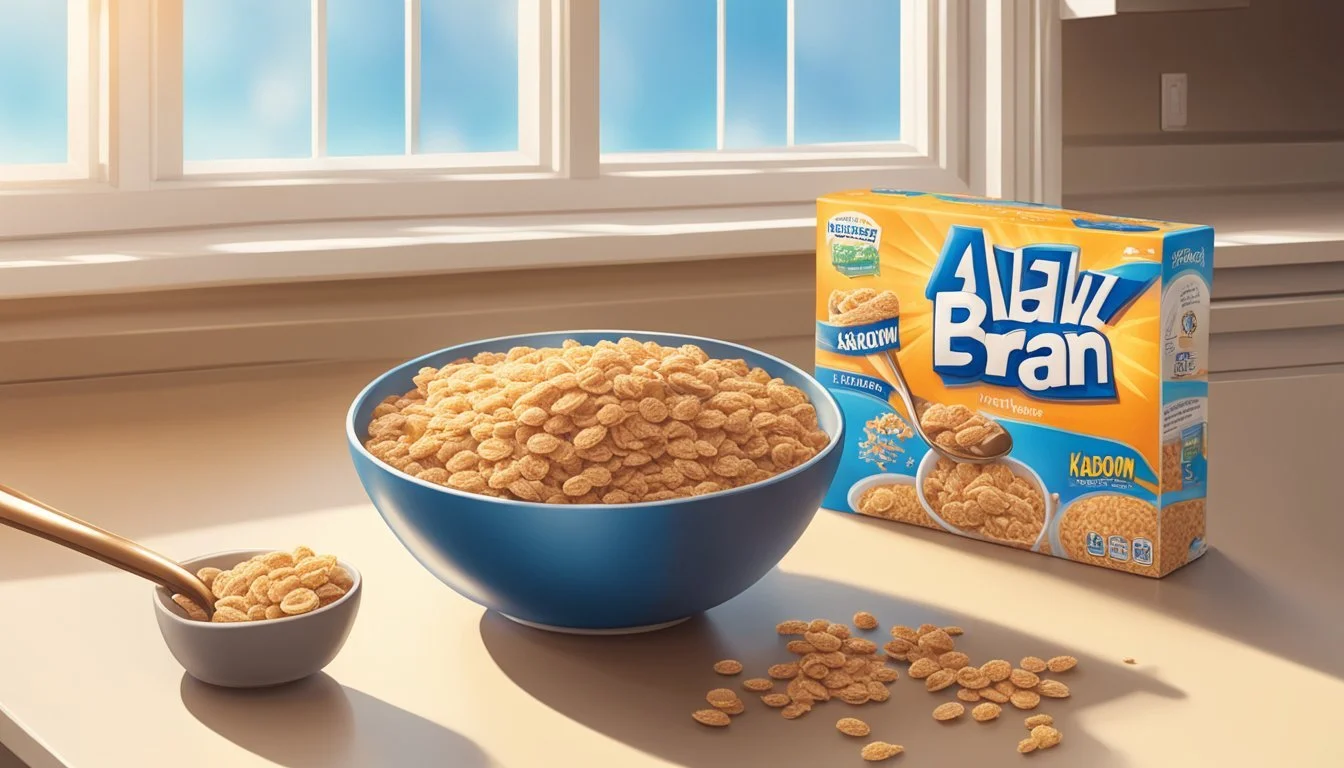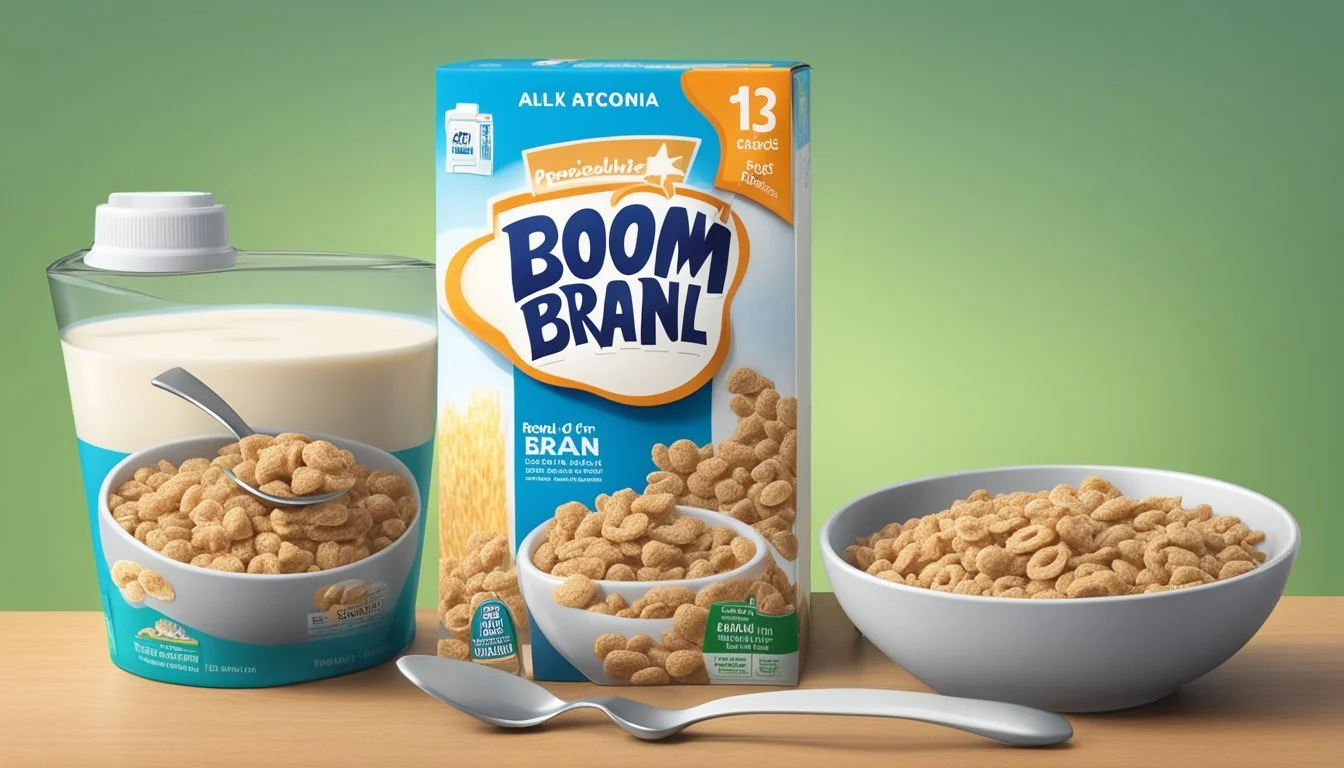All-Bran vs Kaboom
Comparing Nutritional Benefits and Taste
This Article is Part of Our Breakfast Cereal Guide with Details on All-Bran Nutrition and Kaboom Nutrition
Choosing the right breakfast cereal can be a daunting task, especially when trying to balance nutritional benefits with taste preferences. All-Bran and Kaboom each offer distinct advantages for different dietary needs and preferences. All-Bran is widely recognized for its high fiber content, which promotes digestive health. Kaboom, on the other hand, is often favored for its fun, colorful shapes and sweet taste, appealing particularly to children.
All-Bran is a go-to option for those looking to increase their fiber intake and maintain a balanced diet. With a significant amount of fiber per serving, it can aid in digestion and overall gut health. Kaboom provides a more sugary alternative with a vibrant and playful appearance, making it an attractive option for young eaters, though it contains higher sugar levels compared to All-Bran.
While All-Bran focuses on delivering nutritional benefits through fiber and a more balanced nutrient profile, Kaboom prioritizes flavor and visual appeal. Ultimately, the choice between All-Bran and Kaboom depends on individual priorities, whether it’s dietary health or fulfilling a sweet tooth.
Background on Bran Cereals
Bran cereals are commonly chosen for their high fiber content and nutritional benefits. Understanding their nutritional value and history can provide insight into why they are popular choices for health-conscious consumers.
Defining Bran and Its Nutritional Value
Bran is the outer layer of cereal grains, such as wheat, rice, and oats. It is rich in fiber, vitamins, and minerals. Because it is part of the whole grain, bran also contains essential nutrients like B vitamins, iron, magnesium, and zinc.
Incorporating bran into the diet supports digestive health due to its fiber content. It aids in maintaining healthy cholesterol levels and provides a feeling of fullness. A regular serving of bran cereal can contribute significantly to daily fiber intake, aiding overall gastrointestinal health.
History of All-Bran and Kaboom Cereals
All-Bran was introduced by Kellogg's in 1916. It was designed to be a high-fiber cereal option for consumers looking to improve digestive health. The brand has various products that all emphasize the benefits of wheat bran.
Kaboom, a fruity and colorful cereal created by General Mills, entered the market in 1969. Unlike All-Bran, it focused more on a fun breakfast experience for children without losing sight of nutritional aspects. Kaboom also contained essential vitamins and minerals to help support a balanced diet for kids.
Despite their differences, both cereals reflect significant moments in the development of bran-based and nutrient-rich breakfast options. Through different approaches, they contributed to broadening consumer awareness about the health benefits of bran.
Health and Nutrition Comparison
All-Bran and Kaboom are two breakfast cereals with unique nutritional profiles. This section breaks down their fiber content, vitamins and minerals, sugar and fat content, and their macronutrient values to better understand their health benefits.
Fiber Content and Digestive Health Benefits
All-Bran is renowned for its high fiber content. Each serving contains about 11 grams of fiber, primarily from wheat bran. This high fiber content supports digestive health by promoting regular bowel movements and reducing bloating. High fiber intake can also reduce the risk of type 2 diabetes and heart disease.
Kaboom contains less fiber, typically offering around 2 grams per serving. This difference makes All-Bran a stronger choice for those seeking digestive health benefits.
Vitamins and Minerals Profile
All-Bran provides a robust blend of vitamins and minerals. Each serving includes significant amounts of B vitamins, iron, and 50% of the daily recommended Vitamin D intake. These nutrients are essential for energy production, immune function, and bone health.
Kaboom also contains a variety of vitamins and minerals, but the levels are generally lower compared to All-Bran. While Kaboom provides essential nutrients, it falls short in delivering the same level of micronutrients as All-Bran.
Sugar and Fat Content Analysis
All-Bran contains about 7-12 grams of sugar per serving, depending on the variety. While it is not sugar-free, its sugar content is relatively moderate. The fat content is minimal, making it suitable for low-fat diets.
Kaboom, on the other hand, is more sugary, often exceeding 12 grams of sugar per serving. This higher sugar content can contribute to weight gain and increased risk of developing chronic diseases. Kaboom's fat content is also generally low but should be considered in the context of its high sugar levels.
Protein, Carbohydrates, and Caloric Value
All-Bran offers approximately 14 grams of protein per 100 grams, translating to around 3 grams per serving. It also provides a moderate number of calories, with about 80 calories per serving. The carbohydrate content is balanced with its high fiber.
Kaboom provides slightly lower protein content, roughly 10 grams per 100 grams. Each serving delivers around 110 calories, partly due to its higher sugar content. The carbohydrate level is higher, but less of it comes from fiber, resulting in different dietary impacts.
By examining these aspects, individuals can better understand which cereal aligns with their nutritional needs and health goals.
Consumption and Usage
All-Bran and Kaboom cereals offer unique flavors and nutritional profiles, suitable for different needs. Understanding the best ways to enjoy these cereals can enhance your breakfast experience.
Serving Suggestions and Additions
All-Bran is highly versatile. Many enjoy it with milk and a sprinkle of fresh fruit like bananas or berries for added sweetness and vitamins. Nuts and seeds can be stirred in for extra protein and healthy fats.
Kaboom, a colorful cereal, pairs well with milk and can be complemented by a dollop of yogurt. Adding fruits such as strawberries or blueberries increases its nutritional value. Both cereals can be enjoyed dry as a snack or mixed into a trail mix.
Recipes Featuring All-Bran and Kaboom
All-Bran is a popular ingredient in baking. Recipes include bran muffins, pancakes, and energy bars. These not only serve as breakfast items but also as nutritious snacks throughout the day.
Kaboom can be used in more creative recipes. Consider using it as a topping for ice cream or frozen yogurt. It can also be incorporated into cereal bars or cookies, adding a fun and colorful twist.
These recipes allow for experimentation, making both All-Bran and Kaboom diverse options in the kitchen.
Product Varieties and Flavors
Both All-Bran and Kaboom offer distinct product varieties catering to different tastes and nutritional needs. Here, we outline the specific products available and dive into their flavor profiles and taste experiences.
Range of All-Bran and Kaboom Products
All-Bran: All-Bran, a product of WK Kellogg Co, is available in several varieties. The prominent ones include All-Bran Original, which is known for its high fiber content, and All-Bran Buds, which offer a slightly different texture and fiber profile. There's also an All-Bran Bran Flakes variant that combines the benefits of whole grains with wheat bran.
Kaboom: Kaboom cereal, previously produced by General Mills, is known for its colorful appearance and sweet taste. It primarily targets a younger audience with fun, star-shaped multicolored pieces. Though not as diverse in options as All-Bran, it holds a niche for those looking for a nostalgic, sugary cereal experience.
Flavor Profiles and Taste Experience
All-Bran: The flavor of All-Bran cereals leans towards the natural, earthy taste of whole grains and wheat bran. All-Bran Original provides a straightforward, slightly nutty flavor. All-Bran Buds, on the other hand, offer a more compact and crunchier experience with a similar taste profile. Malt flavor is also present in some varieties, subtly enhancing the flavor without overt sweetness. It uses minimal sweeteners, staying true to its high-fiber nutritional aim.
Kaboom: Kaboom is markedly different, with a strong emphasis on sweetness. Each bite is sugary, and artificial flavors are prominent. The cereal pieces are coated with sweeteners, making it a hit among children. The playful colors and shapes further enhance the eating experience, though it is less focused on nutritional content compared to All-Bran.
Impact on Specific Health Conditions
Both All-Bran and Kaboom cereals play distinctive roles in managing specific health conditions, particularly diabetes, weight management, and digestive health.
Role in Managing Diabetes and Blood Sugar Levels
All-Bran contains a high amount of dietary fiber, which can help in controlling blood sugar levels. Consuming high-fiber foods slows down the absorption of sugar, reducing blood sugar spikes. For people with diabetes or those at risk, this is crucial.
In contrast, Kaboom cereal, often high in sugar, can cause rapid increases in blood sugar levels. This makes it a less suitable option for diabetes management. High sugar content can also increase the risk of insulin resistance, contributing to long-term health issues.
Contribution to Weight Management and Obesity
All-Bran, being rich in fiber, can contribute to feelings of fullness, reducing overall calorie intake. This makes it effective for those managing their weight or looking to prevent obesity. Fiber expands in the stomach, promoting satiety and reducing the likelihood of overeating.
Kaboom's higher sugar content, on the other hand, can contribute to weight gain. Calories from sugar are often rapidly absorbed, leading to quicker hunger return. This can result in higher caloric intake over time, potentially leading to obesity if not balanced with physical activity and other dietary choices.
Effects on Digestive Discomfort and Regularity
All-Bran's high-fiber content promotes digestive regularity, reducing constipation and other digestive discomforts. Fiber acts by adding bulk to the stool and speeding up transit time through the intestines. This can significantly improve bowel health and reduce bloating.
Kaboom, with lower fiber content, does not offer the same benefits for digestive health. Consuming cereals low in fiber may lead to slower digestive transit times. This can increase discomfort and lead to irregular bowel movements, making it less ideal for those looking to improve their digestive health.
Consumer Considerations
When comparing All-Bran and Kaboom cereals, it's essential to examine various factors that impact purchasing decisions. These include cost-effectiveness, availability, and nutritional value.
Cost Comparison and Value for Money
When evaluating cereals, price is often a crucial consideration. All-Bran typically comes at a moderate price point, often around $4 for a standard box.
Kaboom, on the other hand, may price slightly higher due to its branding and marketing aimed at children.
Price Comparison Table:
Cereal Average Price (USD) Price Per Serving (USD) All-Bran $4.00 $0.50 Kaboom $4.50 $0.56
These figures highlight the differences in cost per serving, where All-Bran offers a slight edge in value.
Availability and Where to Buy
Both cereals are widely available in major grocery stores and online platforms. All-Bran is a staple in most supermarket chains, making it easily accessible.
Kaboom, while less commonly found, is often available in larger retail stores and online.
Consumers can find All-Bran in stores like Walmart, Kroger, and Target. Given its nostalgic appeal, Kaboom is usually stocked at Walmart and certain specialty stores. Availability in online marketplaces like Amazon also ensures convenience for both options.
Making a Healthy Choice
From a health perspective, All-Bran and Kaboom differ significantly. All-Bran is renowned for its high fiber content, offering substantial digestive benefits.
It provides around 10 grams of fiber per serving, contributing to daily required intake.
Kaboom, however, has a higher sugar content, with about 12 grams of sugar per serving, which is a consideration for those monitoring sugar intake.
Nutritional Highlights:
All-Bran: High fiber, promotes digestive health, moderate sugar.
Kaboom: Higher sugar, marketing aimed at children, fortified with vitamins.
For those with specific dietary needs, All-Bran is often the better choice, offering a healthier profile with fewer preservatives and more whole grains. Kaboom's appeal lies more in its taste and branding but comes with the trade-off of higher sugar content and potential additives.
Environmental and Dietary Implications
The environmental impact and dietary benefits of different cereals are important considerations. This section examines the sustainable production of bran cereal and dietary restrictions that may affect consumer choices.
Sustainability of Bran Cereal Production
Bran cereal production impacts the environment differently compared to other cereals like shredded wheat, Cheerios, and Rice Krispies. Bran is a byproduct of whole grain milling, often derived from wheat or oats, known for high fiber content. Using bran as a cereal ingredient leverages existing agricultural processes and minimizes waste.
Eco-friendly practices in bran cereal production include reduced water usage and lower carbon outputs during cultivation. Unlike rice cultivation, which can release significant methane, wheat and oat farming are less environmentally taxing. Brands prioritizing sustainable sourcing and minimal processing further lower the carbon footprint.
Considerations for Dietary Restrictions
Bran cereal can serve as a fiber supplement due to its high dietary fiber. It is a good choice for individuals seeking to improve digestive health. Gluten-free diets, however, must avoid traditional wheat bran cereals. Alternatives include bran derived from gluten-free grains like corn or rice.
Understanding nutrition facts is crucial. High-fiber cereals like bran typically have lower sugar content compared to sugary options like Kaboom. Conversely, bran cereals are often richer in nutrients, making them a complementary choice to oatmeal for those seeking a balanced diet. Ingredients such as added sugars or artificial colors in some cereals may pose issues for individuals with specific dietary restrictions or preferences.
Selecting the right cereal involves evaluating environmental impacts and dietary needs, ensuring a balance between health benefits and sustainability.
Comparison with Other Fiber Supplements
When comparing All-Bran and Kaboom to other fiber supplements on the market, it's essential to look at the types of fiber they provide and their overall effectiveness, availability, and forms.
All-Bran and Kaboom vs. Alternative Fiber Sources
All-Bran, a bran-based cereal, provides a significant amount of insoluble fiber, beneficial for bowel regularity. Kaboom, on the other hand, offers a variety of fibers but often includes soluble options that help in lowering cholesterol levels and stabilizing blood sugar.
Comparatively, fiber supplements like psyllium seed husk and Metamucil are rich in soluble fiber, which can aid in both digestive health and heart health. Psyllium is especially valued for its ability to form a gel-like consistency when mixed with water, making it effective for alleviating constipation and managing blood sugar levels.
Fiber gummies like Metamucil Fiber Supplement Gummies provide a convenient, chewable option, especially for children and those who dislike pills. These often have a mix of fibers, catering to both gastrointestinal transit and overall metabolic health.
Capsule supplements, such as NOW Supplements Psyllium Husk Caps, offer a quick, easy-to-take solution but with less dietary versatility compared to whole food sources like All-Bran and Kaboom.
Spectrum Essentials Flaxseed is another alternative rich in both soluble and insoluble fibers, but it also adds additional nutrients like omega-3 fatty acids, which All-Bran and Kaboom lack.
Each of these fiber sources offers unique benefits and can be chosen based on individual dietary needs and digestive health goals.










